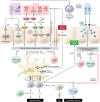Environmental exposures and mechanisms in allergy and asthma development
- PMID: 30741719
- PMCID: PMC6436881
- DOI: 10.1172/JCI124612
Environmental exposures and mechanisms in allergy and asthma development
Abstract
Environmental exposures interplay with human host factors to promote the development and progression of allergic diseases. The worldwide prevalence of allergic disease is rising as a result of complex gene-environment interactions that shape the immune system and host response. Research shows an association between the rise of allergic diseases and increasingly modern Westernized lifestyles, which are characterized by increased urbanization, time spent indoors, and antibiotic usage. These environmental changes result in increased exposure to air and traffic pollution, fungi, infectious agents, tobacco smoke, and other early-life and lifelong risk factors for the development and exacerbation of asthma and allergic diseases. It is increasingly recognized that the timing, load, and route of allergen exposure affect allergic disease phenotypes and development. Still, our ability to prevent allergic diseases is hindered by gaps in understanding of the underlying mechanisms and interaction of environmental, viral, and allergen exposures with immune pathways that impact disease development. This Review highlights epidemiologic and mechanistic evidence linking environmental exposures to the development and exacerbation of allergic airway responses.
Conflict of interest statement
Figures


Similar articles
-
External Environmental Pollution as a Risk Factor for Asthma.Clin Rev Allergy Immunol. 2022 Feb;62(1):72-89. doi: 10.1007/s12016-020-08830-5. Epub 2021 Jan 12. Clin Rev Allergy Immunol. 2022. PMID: 33433826 Free PMC article. Review.
-
Environmental risk factors and allergic bronchial asthma.Clin Exp Allergy. 2005 Sep;35(9):1113-24. doi: 10.1111/j.1365-2222.2005.02328.x. Clin Exp Allergy. 2005. PMID: 16164436 Review.
-
Epidemiologic evidence for asthma and exposure to air toxics: linkages between occupational, indoor, and community air pollution research.Environ Health Perspect. 2002 Aug;110 Suppl 4(Suppl 4):573-89. doi: 10.1289/ehp.02110s4573. Environ Health Perspect. 2002. PMID: 12194890 Free PMC article. Review.
-
Traffic related pollutants in Europe and their effect on allergic disease.Curr Opin Allergy Clin Immunol. 2004 Oct;4(5):341-8. doi: 10.1097/00130832-200410000-00003. Curr Opin Allergy Clin Immunol. 2004. PMID: 15349031 Review.
-
Air pollution and allergic diseases.Curr Opin Pediatr. 2015 Dec;27(6):724-35. doi: 10.1097/MOP.0000000000000286. Curr Opin Pediatr. 2015. PMID: 26474340 Free PMC article. Review.
Cited by
-
Tissue-Resident Memory T Cells in Allergy.Clin Rev Allergy Immunol. 2024 Feb;66(1):64-75. doi: 10.1007/s12016-024-08982-8. Epub 2024 Feb 21. Clin Rev Allergy Immunol. 2024. PMID: 38381299 Review.
-
Influence of Farm Environment on Asthma during the Life Course: A Population-Based Birth Cohort Study in Northern Finland.Int J Environ Res Public Health. 2023 Jan 24;20(3):2128. doi: 10.3390/ijerph20032128. Int J Environ Res Public Health. 2023. PMID: 36767494 Free PMC article.
-
Mediterranean-Type Diets as a Protective Factor for Asthma and Atopy.Nutrients. 2022 Apr 27;14(9):1825. doi: 10.3390/nu14091825. Nutrients. 2022. PMID: 35565792 Free PMC article. Review.
-
Beyond allergic progression: From molecules to microbes as barrier modulators in the gut-lung axis functionality.Front Allergy. 2023 Jan 30;4:1093800. doi: 10.3389/falgy.2023.1093800. eCollection 2023. Front Allergy. 2023. PMID: 36793545 Free PMC article. Review.
-
Prevalence of asthma symptoms and associated risk factors among adults in Saudi Arabia: A national survey from Global Asthma Network Phase Ⅰ.World Allergy Organ J. 2022 Jan 10;15(1):100623. doi: 10.1016/j.waojou.2021.100623. eCollection 2022 Jan. World Allergy Organ J. 2022. PMID: 35079318 Free PMC article.

